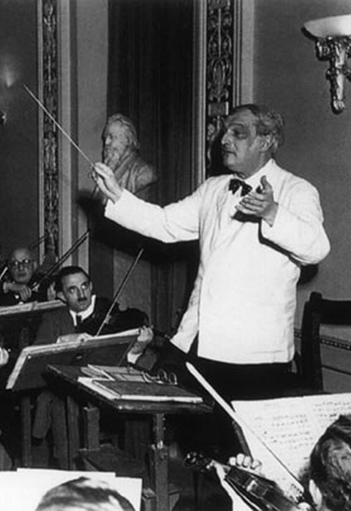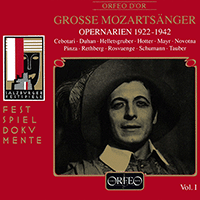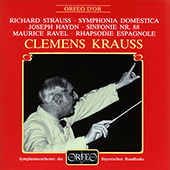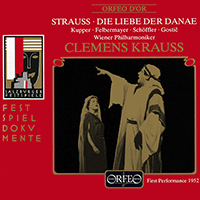Clemens Krauss
Clemens Krauss’s mother was the talented actress and singer Clementine Krauss and his great aunt the soprano Gabrielle Krauss; his father was a member of the imperial household. Having joined the choir of the imperial chapel at the age of eight and earned the praise of Mahler, he went on to study at the Vienna Conservatory where his teachers included Heuberger, Gradener and Reinhold. He gained his first professional appointment in 1912 as chorusmaster at Brno, where he made his conducting debut with Lortzing’s Zar und Zimmermann during the following year. Subsequently Krauss was second conductor at Riga (1913–1914) and Nuremberg (1915–1916), and first conductor at Stettin (1916–1921), where he was conveniently able to hear Nikisch often in Berlin. His first appointment as chief conductor, with responsibility for both opera and symphony concerts, was at Graz in Austria in 1921. Krauss soon came to the attention of Richard Strauss, who as co-director of the Vienna State Opera invited him to Vienna at short notice to conduct Das Rheingold, Die Walkure and his own Der Rosenkavalier: Krauss’s appointment as conductor at the Vienna State Opera followed in 1922. Here he worked with Franz Schalk and developed a close relationship with Richard Strauss, who was to play a major role in his life. He also taught conducting at the Vienna Academy of Music (1922–1924) and was conductor of the Tonkunstler concerts (1923–1927). Between 1924 and 1929 Krauss was chief conductor of the Opera and Museum concerts at Frankfurt; he made his first visit to South America in 1927, and appeared in the USA with the New York Philharmonic and Philadelphia Orchestras during 1929.
In 1929 Krauss returned to Vienna as chief conductor of the State Opera, and also frequently conducted the opera orchestra in its concert-giving guise as the Vienna Philharmonic. He worked closely with Mahler’s favoured designer, Alfred Roller, and in 1930 conducted the Viennese premiere of Alban Berg’s Wozzeck. During this period he was a frequent conductor at the Salzburg Festival, where he had already conducted Ariadne auf Naxos in 1926; he also conducted Der Rosenkavalier when it was first performed at the Festival in 1929. His debut at the Royal Opera House, Covent Garden, followed in 1934. Following the departure of Erich Kleiber as chief conductor at the Berlin Staatsoper in the same year, Krauss took over this position in 1935 and repeated this sequence of events when he replaced Knappertsbusch as chief conductor at Munich in 1937. He also directed the Salzburg Mozarteum between 1939 and 1945, and continued his close association with the Salzburg Festival during World War II.
Although Krauss made no secret of his sympathy with the Nazi party, and was happy to replace conductors who had fallen out with the Nazis, as his moves to Berlin and Munich clearly indicated, he was nevertheless very helpful to Jewish musicians whose lives were threatened by the Nazi regime. He remained in Munich until 1943 when the principal opera house, the National Theatre, was destroyed by allied bombing; and then returned to Vienna where he conducted the last concert of the Vienna Philharmonic before the Russians entered the city. Three weeks later he led the first concert after the liberation of Austria; but at the request of one of the occupying powers he was banned from conducting because of his associations with the National Socialist Party and did not return to the podium until 1947, when he once again conducted the Vienna Philharmonic Orchestra and the Vienna State Opera in its temporary home at the Theater an der Wien. He also returned to teaching in Vienna and henceforth became active as a guest conductor internationally, appearing in Germany, England, France, Italy and South America. Krauss led the Vienna State Opera on a triumphant visit to London in 1947 and conducted Wagner’s Tristan und Isolde at Covent Garden in 1951 as well as Der Ring des Nibelungen and Parsifal at the Bayreuth Festival in 1953. With the rebuilding of the Vienna State Opera he was expected to become its new chief conductor, but this appointment went, possibly as a result of internal politics, to Karl Bohm instead. Krauss died unexpectedly of a heart attack in Mexico City, before the re-opening of the new opera house in Vienna at the end of 1955.
As a close colleague of Richard Strauss, Krauss became an outstanding exponent of that composer’s music, conducting the first performances of Arabella (1933, Dresden, replacing Fritz Busch who had left as a result of Nazi pressure), Friedenstag (1938, Munich), Capriccio, for which he was also the librettist (1942, Munich) and Die Liebe der Danae (1952, Salzburg). Recordings of Krauss conducting all or parts of these operas have survived, as well as Der Rosenkavalier and the second half of Ariadne auf Naxos, and they all fully demonstrate his great skill in this repertoire, as do his commercial recordings of the major tone poems by Richard Strauss, notably an effervescent Till Eulenspiegels lustige Streiche. Many of these operatic recordings feature his wife, the Romanian soprano Viorica Ursuleac. If Krauss’s skill and understanding as a conductor of Richard Strauss’s music has rarely been equalled, he was also an outstanding exponent of the music of the ‘other’ Strauss, Johann II. At the beginning of 1941 Krauss created the tradition of the New Year’s Day concert with the Vienna Philharmonic Orchestra, and recorded for Decca many of Johann Strauss II’s most popular orchestral works as well as an unrivalled account of Strauss’s best-loved operetta Die Fledermaus.
Krauss’s other operatic recordings are uniformly excellent and demonstrate a remarkable theatrical ability and understanding. His radio recording of Der fliegende Hollander, with Hans Hotter in the title role, is brilliantly dramatic, as is his live Salzburg Festival account of Mozart’s Le nozze di Figaro. All his Bayreuth Festival performances from 1953 have been published and demonstrate a lighter approach to Wagner’s music than is often encountered. When he conducted Tristan und Isolde at Covent Garden in 1951, the critic Harold Rosenthal noted, ‘His was a beautiful, subdued reading of the score, imbued with poetry rather than with passion, and was perfectly consistent from the first bar of the prelude to the last of the liebestod.’ These characteristics also typify many of his recordings of orchestral music, several of which, such as another radio recording, of Brahms’s Symphony No. 1, possess a typically Viennese buoyancy of touch. Krauss was one of the major conductors of the first half of the twentieth century, whose exceptional skills are reflected in his relatively small but highly representative discography.
© Naxos Rights International Ltd. — David Patmore (A–Z of Conductors, Naxos 8.558087–90).



















